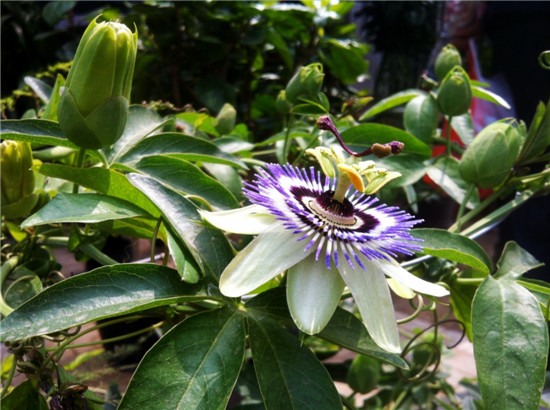The habit and reproduction of passionflower
Passionflower belongs to the family Passiflora, which originated in South America and can be used as a garden ornamental plant. Next, let's take a look at the habits and reproduction of passionflower.

The characteristics of passionflower
Herbaceous lianas; stems cylindrical and slightly angled, glabrous, slightly powdery; leaves papery, 5-7 cm long and 6-8 cm wide, base cordate, palmately 5-parted, middle lobe ovate-oblong, bilateral lobes slightly smaller, glabrous, entire; petiole 2-3 cm long, with 2-4 (- 6) fine glands in the middle Stipules large, reniform, clasping, to 1.2 cm long, margin undulate, Cymes reduced to only 1 flower, opposite tendrils; flowers large, light green, large in diam., 6-8 (- 10) cm; pedicels 3-4 cm long; bracts broadly ovate, 3 cm long, entire; sepals 5, 3-4.5 cm long, pale green outside, greenish white inside, with an angular appendage outside.
Petals 5, light green, nearly as long as sepals; outer corona lobes 3 whorls, filiform, outer and middle whorl lobes, 1-1.5 cm long, apical sky blue, middle white, lower fuchsia, inner lobes filiform, 1-2 mm long, apex with 1 purplish red head, lower part light green; inner corona fimbriate, lobes purplish red, with 1 dense glandular ring under it; disk, about 1-2 mm high. Pistil and stamen stalk 8-10 mm long; stamens 5, filaments separated, ca. 1 cm, flattened; anthers oblong, ca. 1.3 mm; ovary ovoid; styles 3, separated, purplish red, ca. 1.6 cm; stigma reniform. Berry ovoid to subglobose, ca. 6 cm long, orange-yellow or yellow when ripe; seeds numerous, obcordate, ca. 5 mm. The florescence is from May to July.

Growth habits of passionflower
Originated in South America and is a perennial evergreen or semi-woody vine climbing plant. Hometown is 1500 meters above sea level in the Mexican plateau, it is neither cold-resistant, but also afraid of heat, where the climate is warm and cool, there is a period of low-temperature period of dormancy. Passionflower, also known as egg fruit or passion fruit, is also known as "passion fruit". The fruit is sweet and sour, full-bodied and fragrant.
The floral language of passionflower
Although passionflower is native to South America, it can be planted in a greenhouse if it takes more time. It will produce yellow and delicious fruit. People often cultivate this fruit because they want to eat it. Passionflower fruit is like an egg, and its fruit juice is as yellow and attractive as egg yolk, also known as egg fruit. The color of the fruit is yellow, purple and purple-yellow hybrid discoloration. When the fruit is ripe, it smells good to the nostrils. After analysis, scientists found that it has the aroma of pomegranate, pineapple, banana, sour plum, strawberry and other fruits, which can be said to be the most fragrant fruit in the world. So people also call it "passion fruit".

Propagation methods of passionflower
1. This method of root propagation is the most commonly used. Because passionflower can sprout only in the root neck, it must have part of the root neck when it is divided, otherwise it can not germinate new plants. In order to facilitate identification, the method of burying roots in advance is often used to accelerate budding, and then split and planted after the adventitious buds on the root neck germinate. The root-splitting method is simple and easy, the survival rate is high, the seedlings are strong, but the number of propagation plants is limited.
2. Cuttage propagation is the main propagation method of passionflower. The propagation coefficient is large, which is generally carried out in early spring, summer and autumn, and the survival rate is the highest in greenhouse or hotbed from March to April. The cuttings are taken from the tuberous roots which have been accelerated, and the cuttings can be peeled off from the base when a pair of leaves at the base of the new bud unfolds. You can also leave more than one section at the base of the new buds, and then take the buds at the axillary buds with the growth, so that more cuttings can be obtained. The spring seedlings grow fully in summer and autumn and can blossom in the same year. Buds can be taken from growing plants for summer planting from June to early August, but the survival rate is lower than that in spring, but higher than that in summer. It is suitable to insert soil with sandy loam and a small amount of rotten leaf soil or peat.

3. Seed propagation is limited to flower bed varieties and breeding. The seeds are mostly collected from those who mature after autumn cool because of the poor fruiting in summer due to damp and hot. Vertical petal varieties are not easy to obtain seeds, so artificial pollination should be carried out. The sowing is generally carried out in the sowing box, about 20C, sprouting and unearthing in 4-5 days, replanting after the true leaves grow, and flowering after 1-2 years.
The above is the whole content of the habit and reproduction of passionflower that I summarized for you. I hope this article can help you. Please continue to follow us.
Related
- Wuhan Hospital Iron Tree Blooming Result Was Instantly Frightened by the Gardener Master
- Which variety of camellia is the most fragrant and best? Which one do you like best?
- What is the small blue coat, the breeding methods and matters needing attention of the succulent plant
- Dormancy time and maintenance management of succulent plants during dormancy
- Minas succulent how to raise, Minas succulent plant pictures
- What are the varieties of winter succulent plants
- How to raise succulent plants in twelve rolls? let's take a look at some experience of breeding twelve rolls.
- Attention should be paid to water control for succulent plants during dormant period (winter and summer)
- Watering experience of twelve rolls of succulent plants
- Techniques for fertilizing succulent plants. An article will let you know how to fertilize succulent plants.



